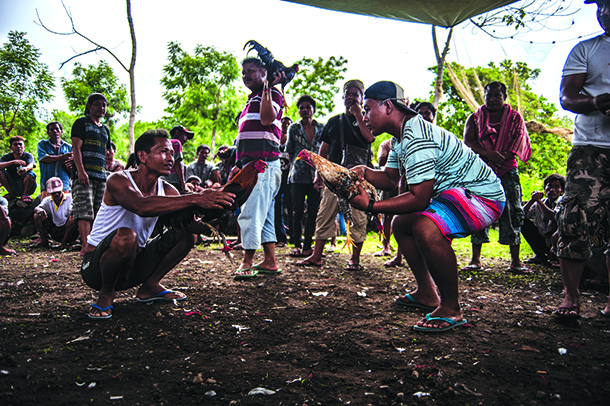
The bloody sport has been outlawed in Indonesia, but in Bali, matches go on in temples and villages
Text Sutanta Aditya
Near Tulamben village in Bali, a battle is taking place in the shadow of Mount Agung. With crops destroyed and tourists fled, the area has become as sluggish as the lava from the volcano, whose recent eruption brought thousands of villagers’ livelihoods to a screeching halt.
But the atmosphere betrays nothing of the grim situation. Instead, the air is thick with cheering; bets are thrust from hand to hand in the gathered crowd. The people are keen to forget, however briefly, the fatigue of their newest hardship amid the excitement of a good match. It’s over in three more moves – with a spatter of blood, the victorious cock mauls its opponent.
Related: Thar be Dragons
To the Balinese, it’s the blood that’s most important in cockfights, not the fortunes that rise and fall with each match. With roots in Hindu ceremonies called tabuh rah, the ancient tradition of pitting fowl against one another is thought to purify agricultural land, glorify the gods, and appease evil spirits by watering the ground with the blood of the vanquished rooster. Even today, such men-only ceremonies are widely held in temples across the region.
“The philosophy of cockfighting is based on the ritual of a blood sacrifice, but has since developed into putting metal spurs on combative roosters – to ensure greater blood loss during the brawl – and taken on high entertainment value,” says 70-year-old Hindu leader I Wayan Subada.
But to have good cockfights, one must have good cocks, and the nuanced process of rooster breeding takes place between carefully selected specimens by professional breeders. Hardy jungle chickens are crossed with larger breeds from countries like the Philippines, and up to 10 specimens of rooster can be test-bred in order to hatch the strongest chicks.
Related: King and Queen of Kalimantan’s Jungle
These precious pets are well-pampered: Vaccinated, fed, massaged and bathed, they’re kept in a shady spot in the jungle, and given a harem of hens with which to mate.
An ideal father must be a champion fighter with a high victory rate, so his offspring will be as powerful, according to 35-year-old cockfighting activist I Nyoman Darma. The best specimens have a good skeletal structure, shiny foot scales and pretty plumage – vibrant orange and iridescent black and gold feathers. Splotches or freckles are not tolerated.
“People today might breed bloodthirsty birds for betting fights,” says Nyoman. “But the original aspiration of the profession is noble: to produce a classy specimen that is proud, pure and elegant. Such a bird brings luck to
its owner.”
Related: Saving Gili’s Horses
For more stories and photographs from this issue, see Asian Geographic Issue 130, 2018